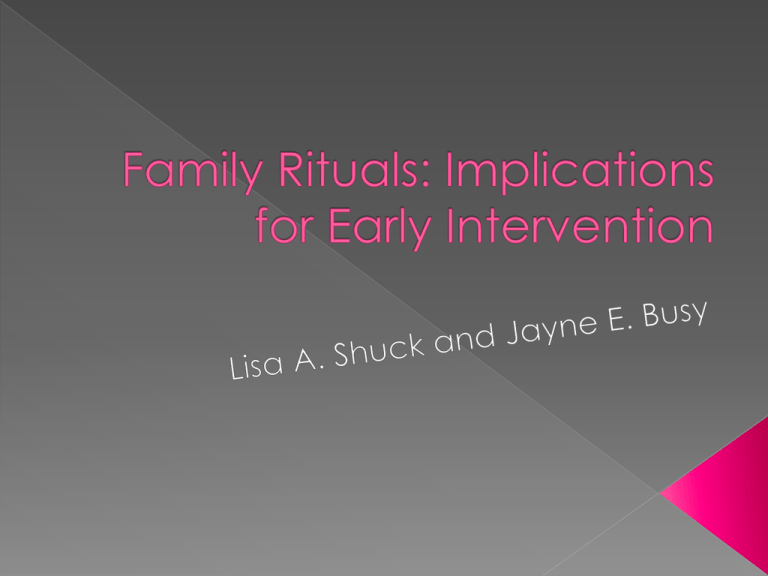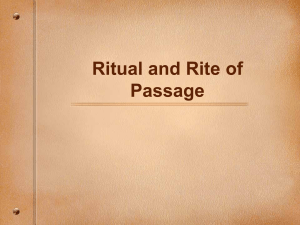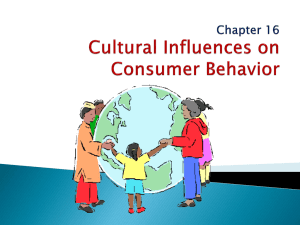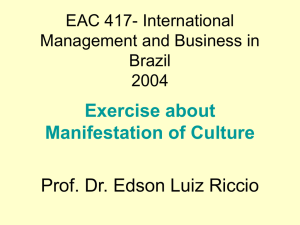Family Rituals - Southeastern Louisiana University
advertisement

Families play a key role in children’s developmental outcomes › Specific intervention plans Garbarino (1990) used the ecological model to show that all environments have an impact on child development › Family rituals are especially important “Family rituals are repetitious, highly valued, symbolic social activities that transmit the family’s enduring values, attitudes, and goals and are essentially ‘the core of the family culture.’” Three universal types of rituals: › Family celebrations › Family traditions › Daily routines Family celebrations – highly organized rituals that are standard across families › Religious holidays, secular holidays, and rites of passage Family traditions - moderately organized, less culture specific, and more idiosyncratic to the family › Vacations, visits from family, family reunions, birthday and anniversary customs, and special parties with ethnic food and music Daily rituals – the least standardized across families, the most variable over time, and the most enacted › Dinnertime customs, bath-time rituals, bedtime practices, etc... Distinction between daily rituals and daily routines › Daily rituals have symbolic meaning; daily routines do not have symbolic meaning Routine Ritual Behaviorally Bound Affectively Bound Concrete Symbolic Mundane Magical Minimal planning or rote Intensely planned Teaches task Teaches culture Gives life order Gives life meaning Rituals are powerful organizers of behavior within the family system that provide the family with a sense of stability, a unique identity, and a means for socializing children within their cultural context Functions: stability, identity, socialization Rituals provide stability for families in times of crisis or stress Hill’s ABCX model (family stress model) Family rituals represent a crisis-meeting resource › Empirical evidence: alcoholism transfer Stability for mothers of children with developmental disabilities Andes survivors’ use of rituals (e.g. rosary) could have contributed to their ability to handle crisis situations (e.g. avalanche) Rituals can provide a family and members of the family with a sense of identity by creating a sense of belonging and solidarity Through rituals, families are able to passed down family values and beliefs, reinforce the family’s heritage, and recognize change within the family Rituals are the occasions that serve to facilitate social interaction among family members Family rituals are the instances where children learn how to appropriately act in social situations “please” and “thank you” Research has shown that families that use less family rituals are more likely to have children with behavior disorders or problem behaviors Assessment of family rituals is one aspect of a comprehensive assessment of family resources, priorities, and concerns Interviews are mostly used to get a description of the dimensions of rituals Four dimensions of rituals › › › › Structure Meaning Persistence adaptability Structure refers to the core elements of rituals: what, when, where, and who Families that rarely engage in rituals are more likely to miss out a sense of family identity, stability, and socialization opportunities Example: Sleeping twin boys Symbolic significance of the rituals; affective content or meaning associated with enactment of the rituals Rituals associated with transitions can often lose meaning for a family with a child that has a developmental disability Example: Getting a sitter and going out Commitment of the family to maintaining the rituals despite obstacles to participation, which is protective feature for the family Families that have a child with a disability often find that rituals are neglected or abandoned in response to the needs of their child. Example: evening walks Ability of the family to adapt rituals to meet the needs of the individual or the entire family over time Rituals should be adaptable in order to maintain their meaning Three ways to adapt rituals: › Construct a new ritual › Reinstate a lost ritual › Modify a no longer functional ritual to meet the needs of the family Early interventionists should incorporate and work with family rituals when developing interventions for children with development disabilities. › These interventions are more likely to be practiced, and they are less likely to overburden the family. Example: meal time program › Interventions can include rituals Example: commencement ceremony









